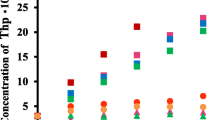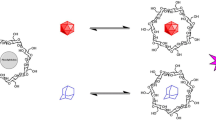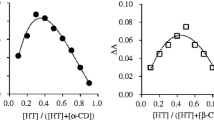Abstract
Phase solubility analysis is used to investigate the complex formation of alfaxalone with various cyclodextrins(2-hydroxypropyl-β-cyclodextrine [HPBCD],β-cyclodextrin [BCD] and2-hydroxypropyl-γ-cyclodextrin [HPGCD]).The complexationwith HPBCD was studied in more detail by looking at the effect of temperature on the stability constants using phase solubility analysis. HPLC-analysis was used to measure the dissolved amount of alfaxalone.The solubility of alfaxalone increases linearly with increasing concentration of cyclodextrin, suggesting the formation of a 1 : 1 complex. For the parent BCD the complex starts precipitating out of solution when the solubilizer concentration exceeds 0.25% making the unsubstituted BCD less useful for the preparation of solutions of alfaxalone. Substituted cyclodextrins do not form insoluble complexes with alfaxalone. The complexation constant for BCD and HPBCD are comparable in magnitude, but for HPGCD, the constant is substantially lower.
The effect of temperature on thecomplexation constant was also studied at elevated temperature. Increasing the temperature results in an increased S0 (solubility without HPBCD) and a decrease in the value of the complexation constant. The net effect results in minor changes of the solubility of alfaxalone as a function of temperature. Based on regression analysis, the change in enthalpy for complex formation between alfaxalone and HPBCD is calculated as -4610 cal/mol.
The results indicate that substitutedcyclodextrins are useful in the preparation of solutions of alfaxalone. Since 1 : 1 complexes are formed there is no theoretical danger for precipitation on dilution, e.g., after injection.
Similar content being viewed by others
REFERENCES
D. Cambell, A. Forrester, D. Miller, I. Hutton, J. Kennedy, T. Lawrie, A. Lorimer, and D. McCall: Br. J. Anaesth. 43, 14 (1971).
P. Tachon, J. Descotes, A. Laschi-Loquerie, J. Guillot, and J. Eureux: Br. J. Anaesth. 55, 715 (1983).
M.E. Brewster, K.S. Estes, and N. Bodor: J. Parenter. Sci. Technol. 43, 262 (1989).
K.S. Estes, M.E. Brewster, A.I. Webb, and N. Bodor: Int. J. Pharm. 65, 101 (1990).
T. Higuchi and K.A. Connors: in C.N. Reilly (ed.), Advances in Analytical Chemistry and Instrumentation, Vol. 4, Wiley-Interscience, New York, p. 117 (1965).
A. Martin: in Williams & Wilkins (eds.), Physical Pharmacy, 4th edn, p. 274 (1993).
S.I.F. Badaway, M.M. Ghorab, and C.M. Adeyeye: Int. J. Pharm. 128, 45 (1996).
J. Szejtli: in Akademiai Kiado (ed.), Cyclodextrins and Their Inclusion ComplexesBudapest, p. 103 (1982).
Rights and permissions
About this article
Cite this article
Speeters, J., Neeskens, P., Adriaensen, J. et al. Alfaxalone: Effect of Temperature on Complexation with 2-Hydroxypropyl-β-cyclodextrin. Journal of Inclusion Phenomena 44, 75–77 (2002). https://doi.org/10.1023/A:1023080832018
Issue Date:
DOI: https://doi.org/10.1023/A:1023080832018




